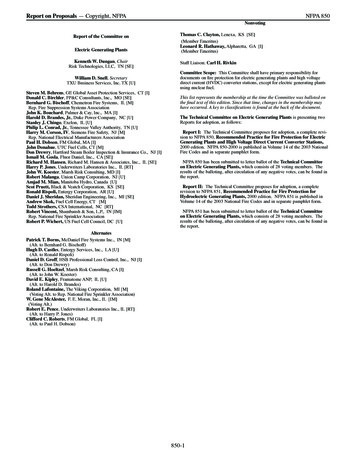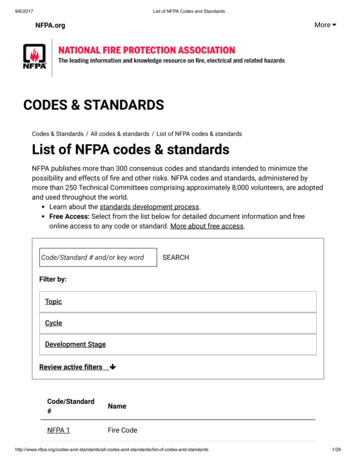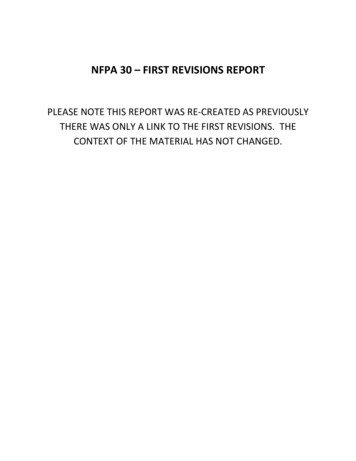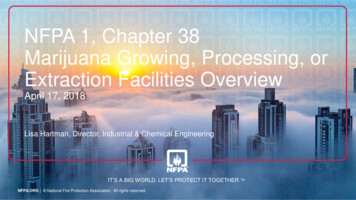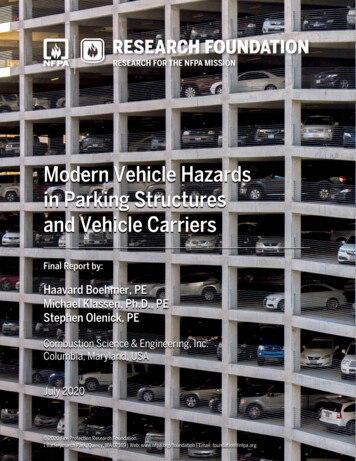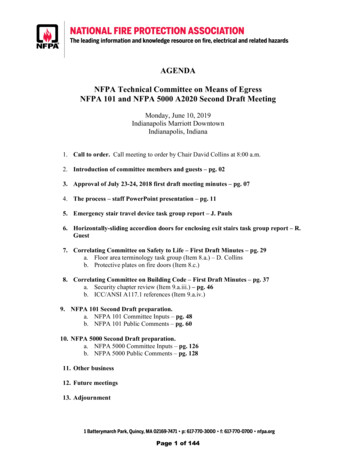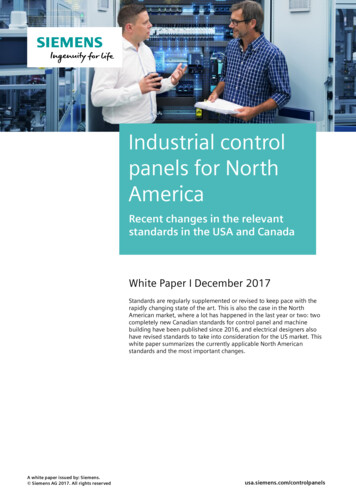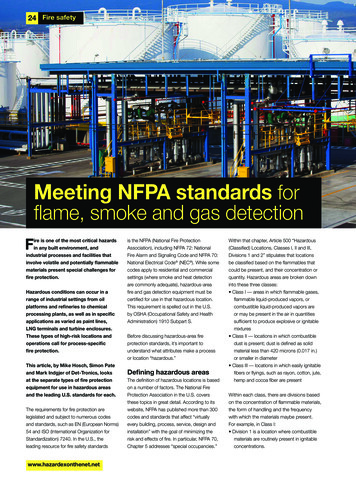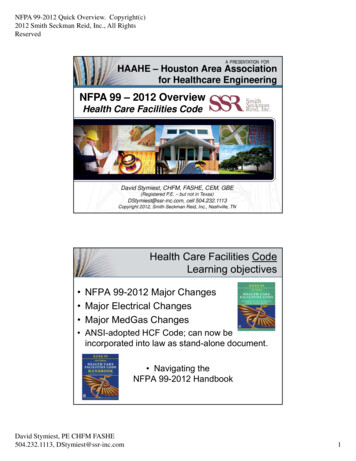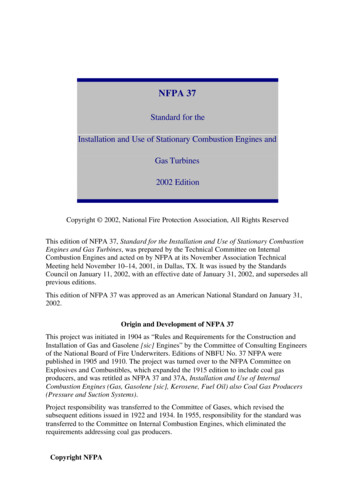
Transcription
NFPA 37Standard for theInstallation and Use of Stationary Combustion Engines andGas Turbines2002 EditionCopyright 2002, National Fire Protection Association, All Rights ReservedThis edition of NFPA 37, Standard for the Installation and Use of Stationary CombustionEngines and Gas Turbines, was prepared by the Technical Committee on InternalCombustion Engines and acted on by NFPA at its November Association TechnicalMeeting held November 10–14, 2001, in Dallas, TX. It was issued by the StandardsCouncil on January 11, 2002, with an effective date of January 31, 2002, and supersedes allprevious editions.This edition of NFPA 37 was approved as an American National Standard on January 31,2002.Origin and Development of NFPA 37This project was initiated in 1904 as “Rules and Requirements for the Construction andInstallation of Gas and Gasolene [sic] Engines” by the Committee of Consulting Engineersof the National Board of Fire Underwriters. Editions of NBFU No. 37 NFPA werepublished in 1905 and 1910. The project was turned over to the NFPA Committee onExplosives and Combustibles, which expanded the 1915 edition to include coal gasproducers, and was retitled as NFPA 37 and 37A, Installation and Use of InternalCombustion Engines (Gas, Gasolene [sic], Kerosene, Fuel Oil) also Coal Gas Producers(Pressure and Suction Systems).Project responsibility was transferred to the Committee of Gases, which revised thesubsequent editions issued in 1922 and 1934. In 1955, responsibility for the standard wastransferred to the Committee on Internal Combustion Engines, which eliminated therequirements addressing coal gas producers.Copyright NFPA
Revised editions of the document were issued in 1959, 1963, 1967, 1970, 1975, 1979,1984, 1990, 1994, and 1998.For the 1998 edition, the following changes of significance were made: (1) majorrestructuring of the document; (2) removal of the 7500 hp limitation in the scope of thestandard; (3) clarification of the definition for an “engine enclosure” and addition of adefinition for “engines for emergency use”; (4) clarification of requirements for fuel tanksand fuel supply for liquid-fueled engines; (5) inclusion of guidance for the installation ofgas trains for gaseous-fueled engines; and (6) addition of requirements for engine exhaustsystems.The 2002 edition includes format and technical revisions. The 2000 edition of the NFPAManual of Style was applied in this document's restructure and format. Introductorymaterial in Chapter 1 has been formatted for consistency among all NFPA documents.Referenced publications that apply to the document have been relocated from the lastchapters to Chapter 2, resulting in the renumbering of chapters. Informational referencesremain in the last annex. Appendices are now designated as annexes. Definitions in Chapter3 have been reviewed for consistency with definitions in other NFPA documents, aresystematically aligned, and are individually numbered. Paragraph structuring has beenrevised with the intent of one mandatory requirement per section, subsection, or paragraph.Information that often accompanied many of the requirements was moved to Annex A,Explanatory Material. Exceptions have been deleted or rephrased in mandatory text, unlessthe exception represents an allowance or required alternate procedure to a general rulewhen limited specific conditions exist. The format appearance and structure providecontinuity among NFPA documents, clarity of mandatory text, and greater ease in locatingspecific mandatory text.The significant content changes concern spill prevention and containment throughprovisions for glass sight gauges or sight feeds for lubricating oil, and fuel spillcontainment requirements.Technical Committee on Internal Combustion EnginesJames B. Biggins, ChairMarsh Risk Consulting, IL [I]Stephen P. Wetter, SecretaryCaterpillar Inc., GA [M]Bernhard G. Bischoff, Chemetron Fire Systems, IL [M]Kenneth M. Elovitz, Energy Economics, Inc., MA [SE]Robert Ely, San Diego, CA [E]Thomas G. Euson, 3S, Inc., OH [IM]Matthew T. Gustafson, Marioff, Inc., MD [M]Copyright NFPA
Henry I. Morehead, Morehead Engineers, WA [SE]Owen M. Preston, Palatka, FL [SE]Y. R. Reddy, R-B Pumps, Inc., GA [M]Clifford C. Roberts, FM Global, FL [I]Richard Scott, Chubb Group of Insurance Co., MA [I]Ron Shaffer, IEA Inc., WI [M]Robert F. Weir, Hartford Steam Boiler Inspection & Insurance Co., CT [I]AlternateGeorge J. Orme, Marsh Risk USA Inc., OR [I](Alt. to J. B. Biggins)Craig H. Kampmier, NFPA Staff LiaisonCommittee Scope: This Committee shall have primary responsibility for documents on thefire safety of the installation, operation, and control of internal combustion engines,including gas turbine engines, using all types of fuel, within structures or immediatelyexposing structures.This list represents the membership at the time the Committee was balloted on the final textof this edition. Since that time, changes in the membership may have occurred. A key toclassifications is found at the back of the document.NOTE: Membership on a committee shall not in and of itself constitute an endorsement ofthe Association or any document developed by the committee on which the member serves.NFPA 37Standard for theInstallation and Use of Stationary Combustion Engines and Gas Turbines2002 EditionNOTICE: An asterisk (*) following the number or letter designating a paragraph indicatesthat explanatory material on the paragraph can be found in Annex A.Information on referenced publications can be found in Chapter 2 and Annex B.Chapter 1 Administration1.1 Scope.This standard establishes criteria to minimize the hazards of fire during the installation andoperation of stationary combustion engines and gas turbines.Copyright NFPA
1.2 Purpose.This standard provides minimum fire safety requirements for the installation and operationof stationary combustion engines and gas turbines.1.3 Application.1.3.1* This standard applies to stationary combustion engines and gas turbines. Thisstandard also applies to portable engines that remain connected for use in the same locationfor a period of one week or more.1.3.2 This standard applies to new installations and to those portions of existing equipmentand installations that are changed or modified.1.3.3 The effective date of application of this standard is not determined by NFPA. Allquestions related to applicability shall be directed to the authority having jurisdiction.1.4 Equivalency.1.4.1 Nothing in this standard is intended to prevent the use of systems, methods, ordevices of equivalent or superior quality, strength, fire resistance, effectiveness, durability,and safety to those prescribed by this standard, provided technical documentation issubmitted to the authority having jurisdiction to demonstrate equivalency, and the system,method, or device is approved for the intended purpose.1.4.2* In determining the suitability of the equipment or component for use, the authorityhaving jurisdiction shall consider the following:(1)The equipment or component is listed for the intended use.(2)The equipment or component meets the requirements of applicable standardsthrough stamping or certification.(3)The equipment or component displays the mechanical strength and durability forthe intended application.(4)The equipment or component is used in the same or a similar application as in thisdocument.1.5 Units and Formulas.1.5.1* Metric units of measurement in this standard are in accordance with the modernizedmetric system known as the International System of Units (SI). These units are listed inTable 1.5.1 with conversion factors. Two units (liter and bar), outside of but recognized bySI, are commonly used in international fire protection.Table 1.5.1 Unitsof yright NFPA
metermmillim barbarbarm31 ft 0.3048m1 in. 25.4mm1 gal 3.785L1 gal 3.785dm31 ft 3 0.0283m31 psi 6894.757 Pa1 psi 0.0689bar1 bar 105 Pa1.5.2 If a value for a measurement as given in this standard is followed by an equivalentvalue in other units, the first stated shall be regarded as the requirement. A given equivalentvalue shall be considered to be approximate.Chapter 2 Referenced Publications2.1 General.The documents or portions thereof listed in this chapter are referenced within this standardand shall be considered part of the requirements of this document.2.2 NFPA Publications.National Fire Protection Association, 1 Batterymarch Park, P.O. Box 9101, Quincy, MA02269-9101.NFPA 10, Standard for Portable Fire Extinguishers, 1998 edition.NFPA 11A, Standard for Medium- and High-Expansion Foam Systems, 1999 edition.NFPA 12, Standard on Carbon Dioxide Extinguishing Systems, 2000 edition.NFPA 12A, Standard on Halon 1301 Fire Extinguishing Systems, 1997 edition.NFPA 13, Standard for the Installation of Sprinkler Systems, 1999 edition.NFPA 15, Standard for Water Spray Fixed Systems for Fire Protection, 2001 edition.NFPA 17, Standard for Dry Chemical Extinguishing Systems, 1998 edition.Copyright NFPA
NFPA 30, Flammable and Combustible Liquids Code, 2000 edition.NFPA 54, National Fuel Gas Code, 1999 edition.NFPA 58, Liquefied Petroleum Gas Code, 2001 edition.NFPA 70, National Electrical Code , 2002 edition.NFPA 72 , National Fire Alarm Code , 1999 edition.NFPA 211, Standard for Chimneys, Fireplaces, Vents, and Solid Fuel-Burning Appliances,2000 edition.NFPA 750, Standard on Water Mist Fire Protection Systems, 2000 edition.NFPA 2001, Standard on Clean Agent Fire Extinguishing Systems, 2000 edition.2.3 Other Publications.2.3.1 API Publications.American Petroleum Institute, 1220 L Street, NW, Washington, DC 20005.API 620, Design and Construction of Large Welded Low-pressure Storage Tanks, 1996.API 650, Welded Steel Tanks for Oil Storage, 1998.2.3.2 ASME Publications.American Society of Mechanical Engineers, Three Park Avenue, New York, NY 100165990.ANSI/ASME Boiler and Pressure Vessel Code, 1998.ANSI/ASME B31.3, Process Piping, 1999.2.3.3 MSS Publication.Manufacturer's Standardization Society of the Valve & Fittings, Inc., 127 Park Street NE,Vienna, VA 22180.MSS SP-69 Pipe Hangers & Supports — Selection & Application, 1996.Chapter 3 Definitions3.1 General.The definitions contained in this chapter shall apply to the terms used in this standard.Where terms are not included, common usage of the terms shall apply.3.2 NFPA Official Definitions.3.2.1* Approved. Acceptable to the authority having jurisdiction.3.2.2* Authority Having Jurisdiction (AHJ). The organization, office, or individualresponsible for approving equipment, materials, an installation, or a procedure.Copyright NFPA
3.2.3 Labeled. Equipment or materials to which has been attached a label, symbol, or otheridentifying mark of an organization that is acceptable to the authority having jurisdictionand concerned with product evaluation, that maintains periodic inspection of production oflabeled equipment or materials, and by whose labeling the manufacturer indicatescompliance with appropriate standards or performance in a specified manner.3.2.4* Listed. Equipment, materials, or services included in a list published by anorganization that is acceptable to the authority having jurisdiction and concerned withevaluation of products or services, that maintains periodic inspection of production of listedequipment or materials or periodic evaluation of services, and whose listing states thateither the equipment, material, or service meets appropriate designated standards or hasbeen tested and found suitable for a specified purpose.3.2.5 Shall. Indicates a mandatory requirement.3.2.6 Should. Indicates a recommendation or that which is advised but not required.3.3 General Definitions.3.3.1 Class I Fuel. Any liquid fuel having a flash point below 37.8 C (100 F).3.3.2* Enclosure. A cover intended for the primary purpose of protecting an engine andrelated equipment.3.3.3 Engines. Prime movers such as internal combustion engines, external combustionengines, gas turbine engines, rotary engines, and free piston engines using either gaseousfuels or liquid fuels, or combinations thereof.3.3.3.1 Combustion Gas Turbine Engines. An engine that produces shaft power utilizingthe Brayton (joule) cycle, where atmospheric air is drawn in and compressed; thecompressed air then flows into a combustion chamber where fuel is injected and continuouscombustion occurs, resulting in high-pressure hot gas to the expansion section (turbine)where the heat energy is converted to rotating, mechanical energy.3.3.3.2* Engines for Emergency Use. Engines that operate under limited use conditions tosupport critical operations in the protection of life, property, or both.3.3.3.3 Portable Engines. Engines mounted on skids, wheels, or otherwise arranged so thatthey can be moved from place to place as the required service indicates.3.3.3.4* Reciprocating Engines. An engine that uses a spark plug to ignite a fuel–airmixture (e.g., otto cycle engine) or an engine in which high-pressure compression raises theair temperature to the ignition temperature of the injected fuel oil (e.g., diesel cycle engine).3.3.4 Flue Gas Temperatures. The temperatures of the flue products at the point or pointsof passing close to or through combustible materials, or at the entrance to a chimney,whichever is applicable.3.3.5 Hazardous Location. An area where flammable or combustible gases or liquids, orcombustible dusts or flyings, usually exist.3.3.6* Horsepower Rating (Combustion Gas Turbines). The ANSI standard rated powerof an engine at the output shaft at 1.01325 bar (14.696 psia) at 15 C (59 F) and a relativeCopyright NFPA
humidity of 60 percent.3.3.7* Horsepower Rating (Reciprocating Engines). The power of an engine measured atthe flywheel or output shaft at standard SAE conditions of 752.1 mm Hg (29.61 in. Hg)barometer at 25 C (77 F) inlet air temperature.3.3.8 Remote Location. A location suitably separated from the engine installation so as tobe accessible during an engine fire.3.3.9 Spark Protected. Electrical equipment enclosed in a tight case or protected byshields, screens, or insulation that contains sparks or prevents their emission.3.3.10 Tanks.3.3.10.1* Fuel Tank. A tank containing fuel for an engine(s).3.3.10.2 Engine-Mounted Tank. A fuel tank furnished and mounted on the engine orengine-frame by the engine manufacturer.3.3.11 Zero Governor Regulator. A gas pressure regulator equipped with a counter springbeneath the valve; it requires an external impulse signal such as top loading with pressureor generating vacuum in the downstream piping.Chapter 4 Engines — General Requirements4.1 Engine Locations.4.1.1 General Requirements.4.1.1.1 Engines shall be situated so that they are readily accessible for maintenance, repair,and fire fighting.4.1.1.2* The air supply shall be designed to meet at least the minimum requirements forcombustion, cooling, and ventilation, and to prevent flue gas products from being drawnfrom stacks or flues of boilers or other combustion devices.4.1.1.3* Combustible materials shall not be stored in rooms or enclosures housing engines.Combustible materials required for day-to-day operations/maintenance shall be permittedwhen stored properly.4.1.1.4 Engines fueled by a Class I fuel or liquid-phase LP-Gas shall not be installed inrooms containing fired equipment or open flames.4.1.1.5* Air filters shall be of the type that will not burn freely when exposed to a fire.4.1.2 Engines Located in Structures.4.1.2.1* Detached structures shall be of noncombustible or fire-resistive construction.4.1.2.2* Detached structures shall have ventilation designed to prevent a hazardousaccumulation of flammable vapors or gases, both when the engine is operating or when it isshut down.4.1.2.3 Engine rooms located within structures shall have interior walls, floors, andCopyright NFPA
ceilings of at least 1-hour fire resistance rating.4.1.2.4 The ceiling of rooms located on the top floor of a structure shall be permitted to benoncombustible or protected with an automatic fire suppression system.4.1.2.5* Engine rooms shall have ventilation that is adequate to prevent a hazardousaccumulation of flammable vapors or gases, both when the engine is operating and when itis shut down.4.1.2.6 Engine rooms attached to structures shall comply with 4.1.2.1 and 4.1.2.2 exceptthat the common wall shall have a fire resistance rating of at least 1 hour.4.1.2.7* Openings from an engine room to other sections of the structure shall be providedwith automatic or self-closing fire doors or dampers corresponding to the rating of the wall.4.1.2.8 Rooms containing engines utilizing a Class I fuel shall be located on an exteriorwall. Construction of the exterior wall shall provide ready accessibility for fire-fightingoperations through the provision of doors, access openings, windows, louvers, or lightweight, noncombustible wall panels.4.1.3 Engines Located on Roofs.4.1.3.1 Engines, and their weatherproof housings if provided, that are installed on roofs ofstructures shall be located at least 1.5 m (5 ft) from openings in walls and at least 1.5 m (5ft) from structures having combustible walls. A minimum separation shall not be requiredwhere the following conditions exist:(1)The adjacent wall of the structure has a fire resistance rating of at least 1 hour.(2)The weatherproof enclosure is constructed of noncombustible materials, and it hasbeen demonstrated that a fire within the enclosure will not ignite combustiblematerials outside the enclosure.4.1.3.2* Where an engine or skid-mounted assembly containing an engine is mounted on aroof, the surface, beneath the engine and beyond the engine and any oil containment dike toa minimum distance of 30.5 cm (12 in.), shall be noncombustible.4.1.4 Engines Located Outdoors. Engines, and their weatherproof housings if provided,that are installed outdoors shall be located at least 1.5 m (5 ft) from openings in walls and atleast 1.5 m (5 ft) from structures having combustible walls. A minimum separation shallnot be required where the following conditions exist:(1)The adjacent wall of the structure has a fire resistance rating of at least 1 hour.(2)The weatherproof enclosure is constructed of noncombustible materials, and it hasbeen demonstrated that a fire within the enclosure will not ignite combustiblematerials outside the enclosure.4.2 Foundations.Engines shall be supported on foundations or secured to a noncombustible framework.4.3 Hazardous Locations.Copyright NFPA
In hazardous locations, engines neither compressing a flammable gas nor pumping aflammable liquid shall be installed to meet the following three criteria:(1)In an enclosure of fire-resistive construction(2)Ventilated from a nonhazardous outside area(3)With outside access only4.4 Engines Handling Hazardous Materials (Other Than Their Own Fuel Supply).4.4.1 The use of an engine-driven unit compressing a flammable gas or pumping aflammable liquid shall be permitted provided the combination unit or groups of suchcombined units are isolated from areas not having a similar hazard.4.4.2* Isolation shall be permitted to be achieved by either locating the unit outdoors, or byindoor structural separation in accordance with 4.1.2, except as modified by all of thefollowing:(1)Provision shall be made for the venting of an explosion.(2)Rooms containing combustion engines located within structures shall have interiorwalls, floors, and ceilings of at least 2-hour fire resistance rating.(3)A room or structure as described in (2) shall be ventilated in an approved mannerfrom a nonhazardous area.4.4.3 Engine Accessories for Hazardous Locations.4.4.3.1 Each spark-ignition engine comprising part of a unit for compressing a flammablegas or pumping a flammable liquid shall have magnetos or distributors and coils of thespark-protected type, and all leads positively attached.4.4.3.2 Ventilation openings in such devices shall be protected by a fire screen unless thedevice is purged, pressurized, or otherwise protected in an approved manner.4.4.3.3 Ignition wire shall be positively attached at each end by use of the outer sheath ofthe insulation.4.4.3.4 Spark plugs shall be fully shielded against flashover. Fully radio-shielded sparkplugs or spark plugs provided with insulating boots shall be permitted.4.4.3.5 Flame-arresting equipment shall be attached to the engine air intake to avoidblowoff or rupture. A mechanically attached air filter shall be permitted to meet thisrequirement.4.4.3.6 Starter, generator, and associated electrical equipment attached to engines shall beof the spark-protected type.4.4.3.7 Fan belts shall be electrically conductive (nonsparking).4.5 Electrical Installations.4.5.1 Electrical installations in rooms containing engines shall comply with NFPA 70,National Electrical Code .Copyright NFPA
4.5.2 Engine rooms or other locations shall not be classified as hazardous locations asdefined in Article 500 of NFPA 70, National Electrical Code, solely by reason of theengine fuel, lubricating oil, or hydraulic fluid.4.5.3 Engine Wiring. Wire and insulation materials shall have all of the followingcharacteristics:(1)Capacity to remain flexible over typical engine operating temperature ranges(2)Capacity to have the minimum possible absorption of oils, fuels, and other fluidscommonly found on or near the engine(3)Be rated for continuous use at the maximum range of temperatures that will occurwhere installed4.5.3.1 Wiring shall be protected by either fuses or circuit breakers in accordance with itsampacity.4.5.3.2 The wire shall be stranded annealed copper.4.5.3.3 The ground circuits on engine wiring shall be permitted to be any of the following:(1)Green in color(2)Green in color with yellow trace(3)Braided uninsulated cable4.5.3.4* Electrical control circuits on engines not for emergency use shall be designed toshut down the engine automatically in case of control wire break, disconnect, or cutting.4.5.3.5 The requirements of 4.5.3 shall not apply to ignition wiring, thermocouples, andmicroprocessor wiring.4.5.4 Batteries, wiring, and electrical devices shall be protected against arcing andaccidental shorting.4.6* General Installation Requirements.Engines and their appurtenances shall be installed in accordance with the following:(1)Applicable NFPA codes and standards(2)Industry standards(3)User's requirements(4)Manufacturer's installation instructionsChapter 5 Fuel Supply — Gaseous5.1* Gas Piping.5.1.1 Gas piping shall be installed by one of the following methods:(1)All fuel gas systems at service pressures equal to or less than gauge pressure ofCopyright NFPA
861.8 kPa (125 psi) shall be installed in accordance with NFPA 54, National FuelGas Code.(2)All fuel gas systems at service pressures in excess of 861.8 kPa (gauge pressure of125 psi) other than LP-Gas systems shall be installed in accordance withANSI/ASME B31.3, Process Piping, 1999.(3)LP-Gas systems, whether liquid or vapor phase, shall be installed in accordancewith the provisions of NFPA 58, Liquefied Petroleum Gas Code.5.1.2* Plastic pipe shall not be used to carry fuel within a room housing an engine(s).5.1.3 Approved metallic flexible connectors for protection against damage caused bysettlement, vibration, expansion, contraction, or corrosion shall be permitted.5.1.4 Approved nonmetallic connectors for protection against damage caused bysettlement, vibration, expansion, contraction, or corrosion shall be permitted except for LPGas in the liquid phase.5.2* Gas Trains.Gas trains for engines shall contain at least the following components:(1)Manual shutoff valve(2)Regulator, with vent and control line if needed(3)Low-pressure switch for engines with a 2500 MBH (2.5 million Btu/hr) full-loadinput or greater(4)Automatic safety shutoff valve for engines with a 400 MBH (400,000 Btu/hr) fullload input or greater(5)Automatic control valve(6)Manual leak test valve for engines with a 400 MBH (400,000 Btu/hr) full-loadinput or greater(7)High-pressure switch (manual reset) for engines with a 2500 MBH (2.5 millionBtu/hr) full-load input or greater5.3 Regulators.5.3.1* A gas pressure regulator located inside a structure shall be provided with one of thefollowing:(1)A vent to the outside of the structure that discharges at least 1.5 m (5 ft) awayfrom any structure opening(2)Any regulator or zero governor that operates with gas pressure on both sides of thediaphragm(3)A full lock-up regulator(4)A listed vent-limiting deviceCopyright NFPA
5.3.2 When the gas pressure on the upstream side of a non-full lock-up regulator is morethan a gauge pressure of 3.5 kPa (0.5 psi), a relief valve shall be installed on thedownstream side of the regulator and vented to the outside of the structure, discharging atleast 1.5 m (5 ft) away from any structure opening.5.3.2.1 Such relief valves and any connected piping shall be sized to vent the requiredvolume of gas.5.4 Shutoff Valves.5.4.1* Gaseous fuel piping to each engine shall have an approved manual shutoff valve ina remote location.5.4.2 In multiple-engine installations, the shutoff valve shall be located no closer to theengine than the first takeoff or branch pipe that serves only that engine.5.4.3 If the shutoff valve is locked open, the key shall be secured in a well-marked,accessible location near the valve.5.4.4 Every gaseous-fueled engine shall have one of the following devices that willautomatically shut off the flow of fuel in the event the engine stops from any cause:(1)A carburetion valve(2)Zero governor–type regulating valve(3)Fuel control valve(4)Auxiliary valve5.4.5 Automatically started or unattended engines shall be provided with a control valve oran auxiliary valve that will stop the flow of fuel in the event the engine stops for any cause.5.4.5.1 A zero governor–type regulator alone shall not be adequate protection in suchinstallations.5.4.5.2 The auxiliary valve shall be installed ahead of any flexible connector to thecarburetion valve, zero governor, or other controls.5.5 Pressure-Boosting Equipment.5.5.1 Boosters or compressors, if used, shall be approved for the service intended.5.5.2 Receivers, if used, shall be certified with a stamp that they have been designed,constructed, and tested as required by Section VIII, Division 1, “Pressure Vessels,” of theANSI/ASME Boiler and Pressure Vessel Code.Chapter 6 Fuel Supply — Liquid6.1* Design and Construction of Liquid-Fueled Tanks.Fuel tanks shall meet one of the following criteria:(1)Be constructed in accordance with the applicable tank specifications in NFPA 30,Copyright NFPA
Flammable and Combustible Liquids Code(2)Be listed as “Steel-Inside Tanks for Oil Burner Fuel”(3)Be listed as “Underground Tanks for Flammable Liquids”(4)Be listed as “Aboveground Tanks for Flammable Liquids”(5)Be constructed in accordance with API 650, Welded Steel Tanks for Oil Storage(6)Be constructed in accordance with API 620, Design and Construction of LargeWelded Low-pressure Storage TanksException: Fuel tanks mounted on the engine by the manufacturer for gravity feed to acarburetor.6.1.1 Metallic tanks shall be liquidtight with welded or brazed joints.6.1.2 Nonmetallic tanks shall be of liquidtight, one-piece construction.6.2* Installation Criteria for Fuel Tanks Containing Class I Fuels.6.2.1 Tanks for Class I fuels other than engine-mounted tanks shall be located undergroundor aboveground outside of structures.6.2.2 Engine-mounted tanks shall not exceed 95 L (25 gal) capacity.6.2.3 Not more than one tank shall be installed on each engine.6.2.4 Engine-mounted tanks shall be securely mounted on the engine assembly andprotected against all of the following:(1)Vibration(2)Physical damage(3)Engine heat(4)The heat of exhaust piping6.2.5* Fuel tanks shall be installed in accordance with NFPA 30, Flammable andCombustible Liquids Code.6.3* Installation Criteria for Fuel Tanks Containing Liquid Fuels Other Than Class IFuels.6.3.1 General. Engine-mounted tanks shall be securely mounted on the engine assemblyand protected against all of the following:(1)Vibration(2)Physical damage(3)Engine heat(4)The heat of exhaust piping6.3.2 Fuel Tanks Inside Structures.Copyright NFPA
6.3.2.1 Fuel tanks inside structures shall be securely mounted on noncombustible supports.6.3.2.2* Fuel tanks not in a room by themselves shall not exceed 2500 L (660 gal). Fueltanks larger than 2500 L (660 gal) capacity shall be enclosed in a room in accordance with6.3.5 or 6.3.6. Not more than one such 2500 L (660 gal) capacity tank, or two or more ofthese tanks with an aggregate capacity of not more than 2500 L (660 gal), shall beconnected to one engine.Exception: Fuel tanks of any size shall be permitted within engine rooms or mechanicalspaces, provided the engine or mechanical room is designed using recognized engineeringpractices with suitable fire detection, fire suppression, and containment means to preventthe spread of fire beyond the room of origin.6.3.2.3* The aggregate capacity of all fuel tanks in a structure shall not exceed 5000 L(1320 gal) unless that portion exceeding 5000 L (1320 gal) is enclosed in a room inaccordance with 6.3.5 or 6.3.6.Exception: Fuel tanks of any size shall be permitted within engine rooms or mechanicalspaces provided the engine or mechanical room is designed using recognized engineeringpractices with suitable fire detection, fire suppression, and containment means to preventthe spread of fire beyond the room of origin.6.3.2.4 Fuel tanks within structures shall be provided with spill containment consisting ofeither a wall, a curb, or a dike having a capacity at least equal to that of the largestsurrounded tank.Exception: A spill containment system of lesser capacity equipped with an overflow ordrainage system that is adequate in size and location to convey any spillage of fuel to atank (inside or outside) or to a safe area outside the structure.6.3.3 Fuel Tanks Outdoors (Abovegrou
NFPA 30, Flammable and Combustible Liquids Code, 2000 edition. NFPA 54, National Fuel Gas Code, 1999 edition. NFPA 58, Liquefied Petroleum Gas Code, 2001 edition. NFPA 70, National Electrical Code , 2002 edition. NFPA 72 , National Fire Alarm Code , 1999 edition. NFPA 211, Standard for Chimneys, Fireplaces, Vents, and Solid Fuel-Burning .
